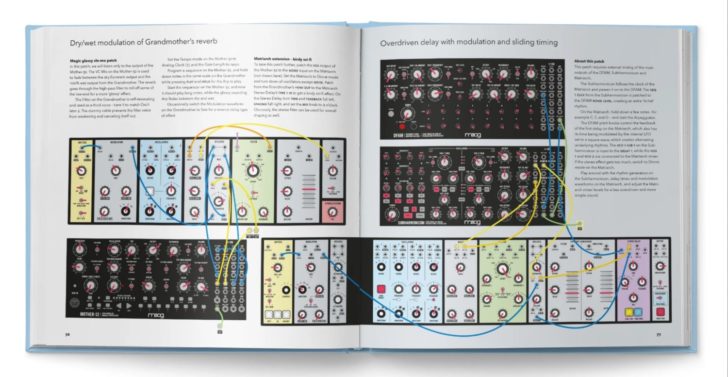Author, designer, and electronic musician Kim Bjørn, in collaboration with Moog Music, recently published a new book in his series for electronic musicians (Patch & Tweak, Pedal Crush, Push Turn Move) – Patch & Tweak With Moog.
With Patch & Tweak With Moog, Bjørn works within his trademark style of thoughfully-organized and profusely illustrated pages, but for the first time focuses on a single brand of gear.
The book’s focus is on deepening your knowledge of synthesis with Moog’s mainstream patchable instruments – the Mother-32, DFAM, Subharmonicon, Grandmother & Matriarch. It offers historical information on Moog’s original modulars and a timeline and overview of Moog instrument designs, but the bulk of the book focuses on the company’s current lineup of patchable synthesizers.
The book is top-notch in every way.
Like Bjørn’s previous books, Patch & Tweak With Moog is gorgeous. You can flip to any random spread and find something that draws you in. It offers reams of basic information about synthesis, and pairs that with detailed illustrations and photographs that demonstrate how you can immediately apply the concepts that are discussed.
The forward is by Hans Zimmer, who shares his personal experience in taking inspiration from early synth albums like Switched On Bach. He also shares this history of his personal Moog modular system, which was originally owned by The Beatles, then The Rolling Stones and then Chris Franke of Tangerine Dream.
In addition, Patch & Tweak With Moog features dozens of interviews. These include artist interviews with musicians like Suzanne Ciani, Trent Reznor, Stranger Things composers Michael Stein and Kyle Dixon, and Moog modular co-designer Herb Deutsch. And it also includes interviews with Moog engineers, who tell the stories of how instruments like the Mother-32 came to be and discuss the inspiration for the unique Subharmonicon.
These interviews are the highlight of the book. They bring to mind the timeless, in-depth interviews that Keyboard magazine used to feature. Each of the interviews is spread across several pages and they are generally accompanied with studio photos, patch tips and gear pairings.
We have two caveats about recommending the book.
First, it really focuses on Moog’s mainstream patchable synths: the Mother-32, DFAM, Subharmonicon, Grandmother & Matriarch. If you really want to know more about the classic Moog modular designs, or if you’ve been dreaming about a Moog One, you won’t find a lot of info on either of them here.
Second, Patch & Tweak With Moog was created in collaboration with Moog Music, so it’s not intended to offer a critical perspective on Moog designs or put them into a context with other synth designs.
With these two caveats in mind, Patch & Tweak With Moog is a must-have book for Moog fans. Readers will learn about Moog history, how the company creates new designs and how artists work with their instruments. And, if you own any of the synths that the book covers in depth, you’ll find patch diagrams to try, insight on the instruments from their creators and inspiration from well-known synthesists.
Pricing & Availability
Patch & Tweak With Moog is available for about $42 USD. If you’re in the US, check the Moog site or a US retailer to avoid international shipping costs.



I put one of these in the cart at the website. When it updated, the current US dollar price converts to $75. With shipping to my my address that turns out to be over $87.00!
Rod – thanks for the feedback. I updated the article to note that you can avoid the international hit by getting it from Moog. It’s also at places like Sweetwater and Perfect Circuit for about $40.
https://www.sweetwater.com/store/detail/PandTMoog–bjooks-ivs-patch-and-tweak-with-moog
If you are in US?
$40 at Sweetwater.
Thank you very much.
I’m holding out for “Patch & Twerk”.
Patch & Twerk with (B)ass
I really wish it had focused more on the actual synths and patches, with less interviews. The format is pretty odd too with the way it jumps around between topics because it has to divide everything up around the interviews.
It’s very much a pickup and read what interests you approach, rather than a cover to cover read.
We now know that Zimmer’s and therefore Tangerine Dream’s Moog didn’t come from The Stones
Do you have more info that you can share on this?
Edgar Froese said that they got their first modular from the Stones and Hans Zimmer says he got it from Chris Franke.
Was Froese wrong? Is Zimmer just repeating the story because it’s a great story?